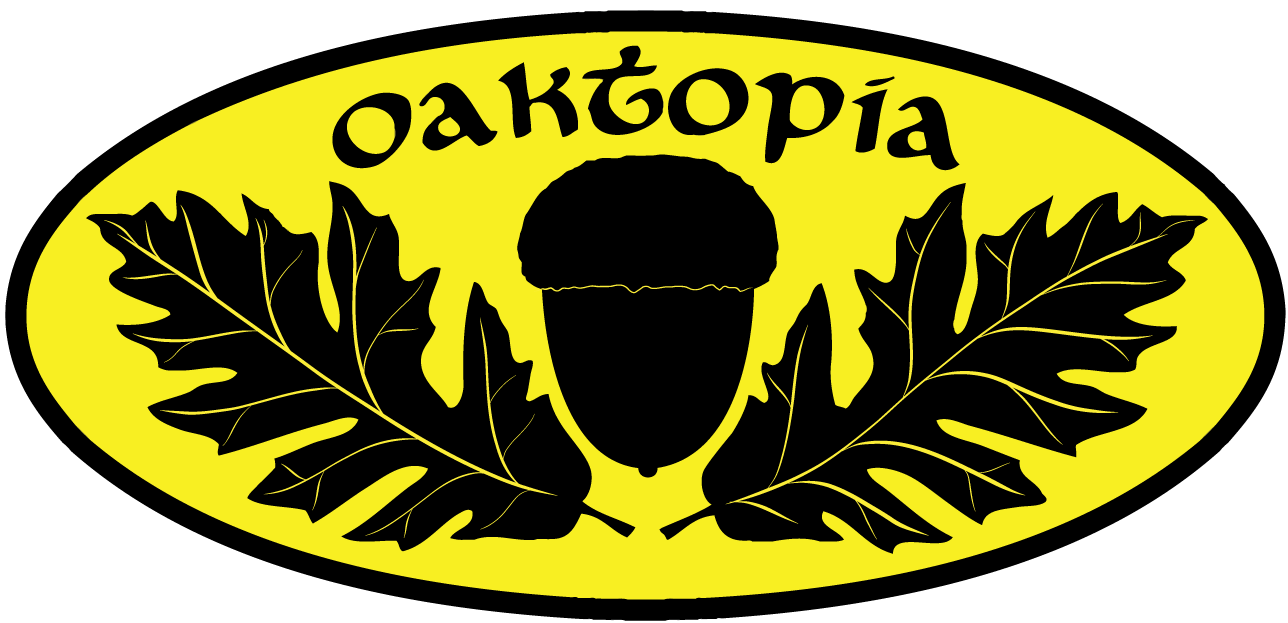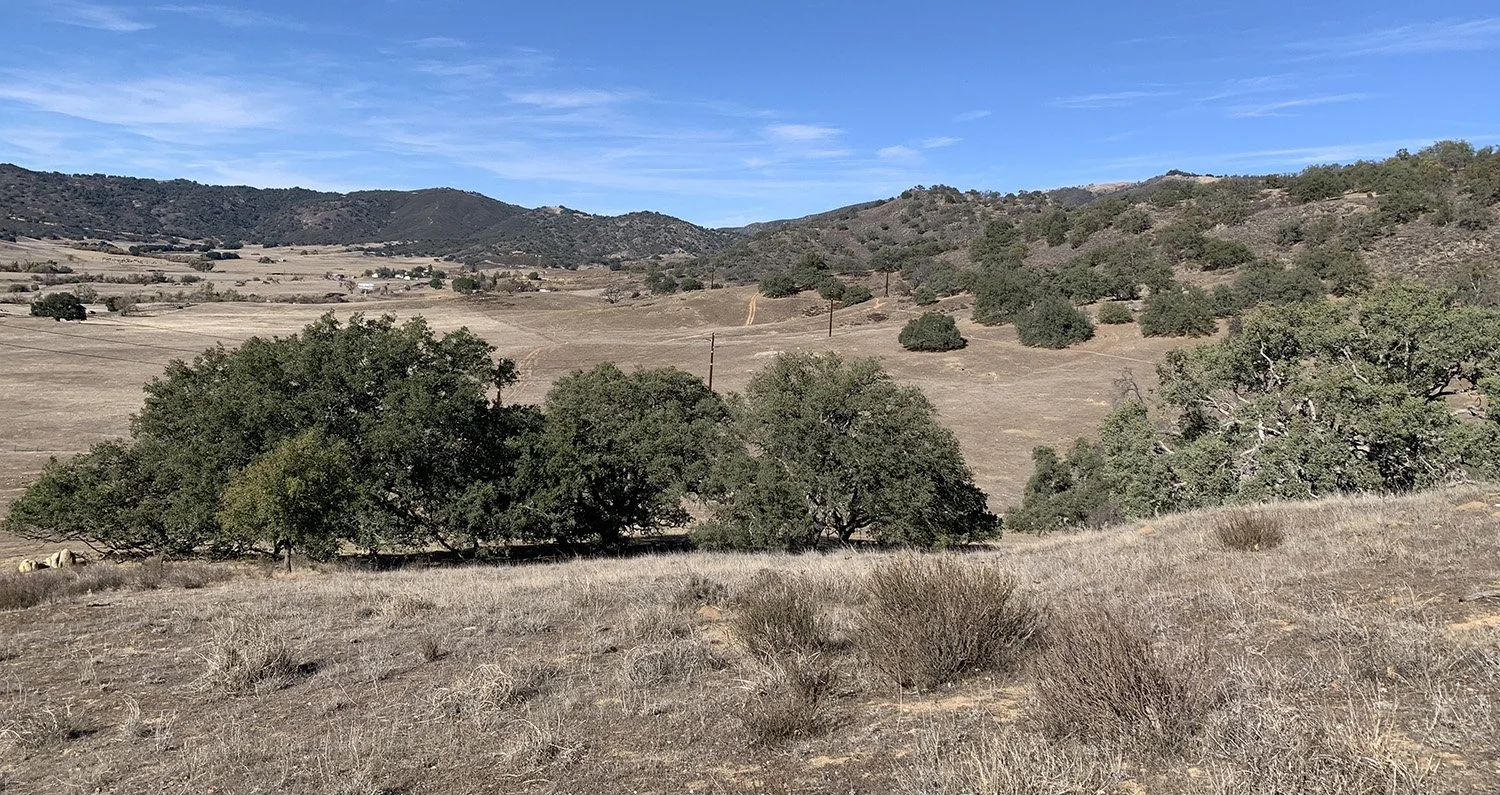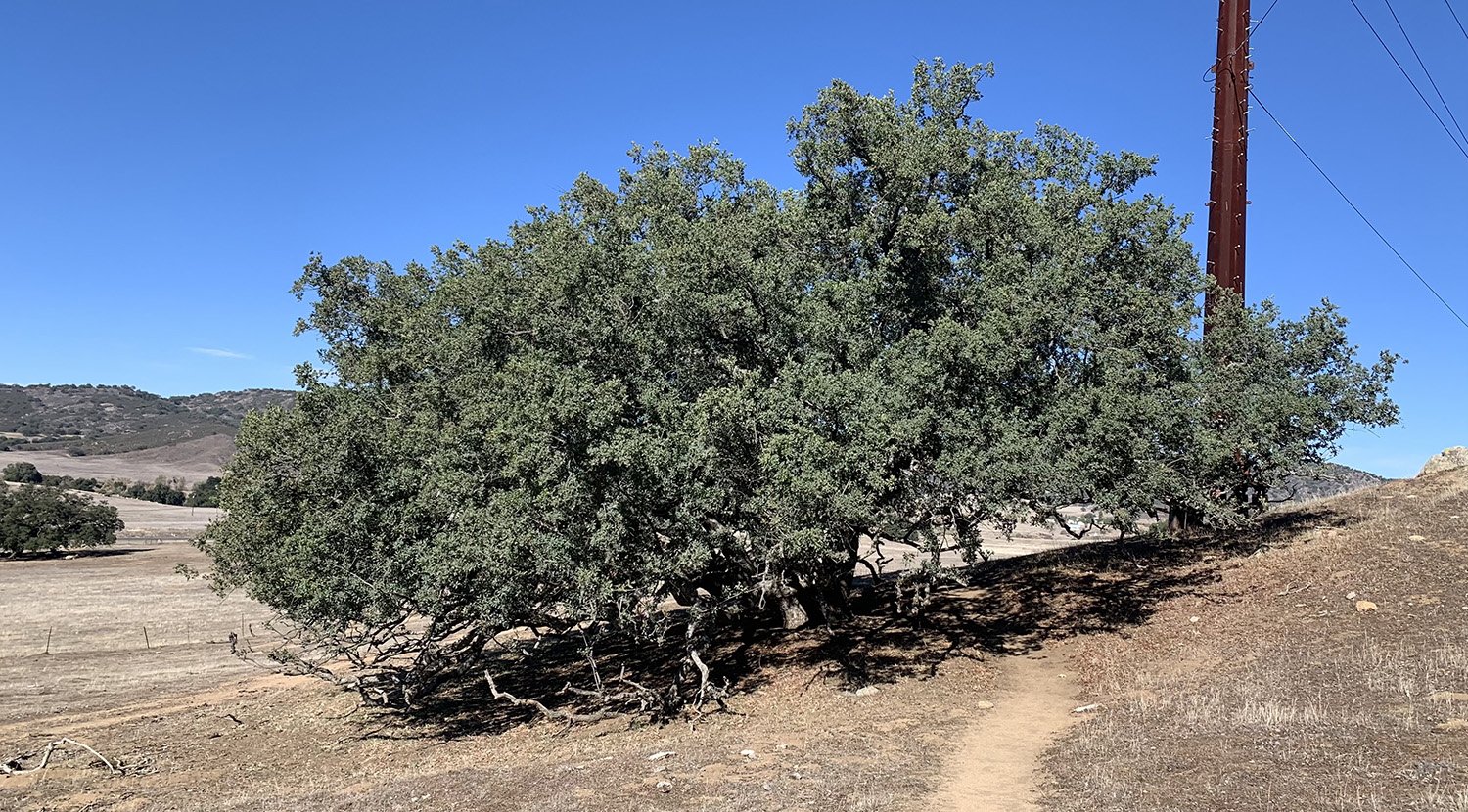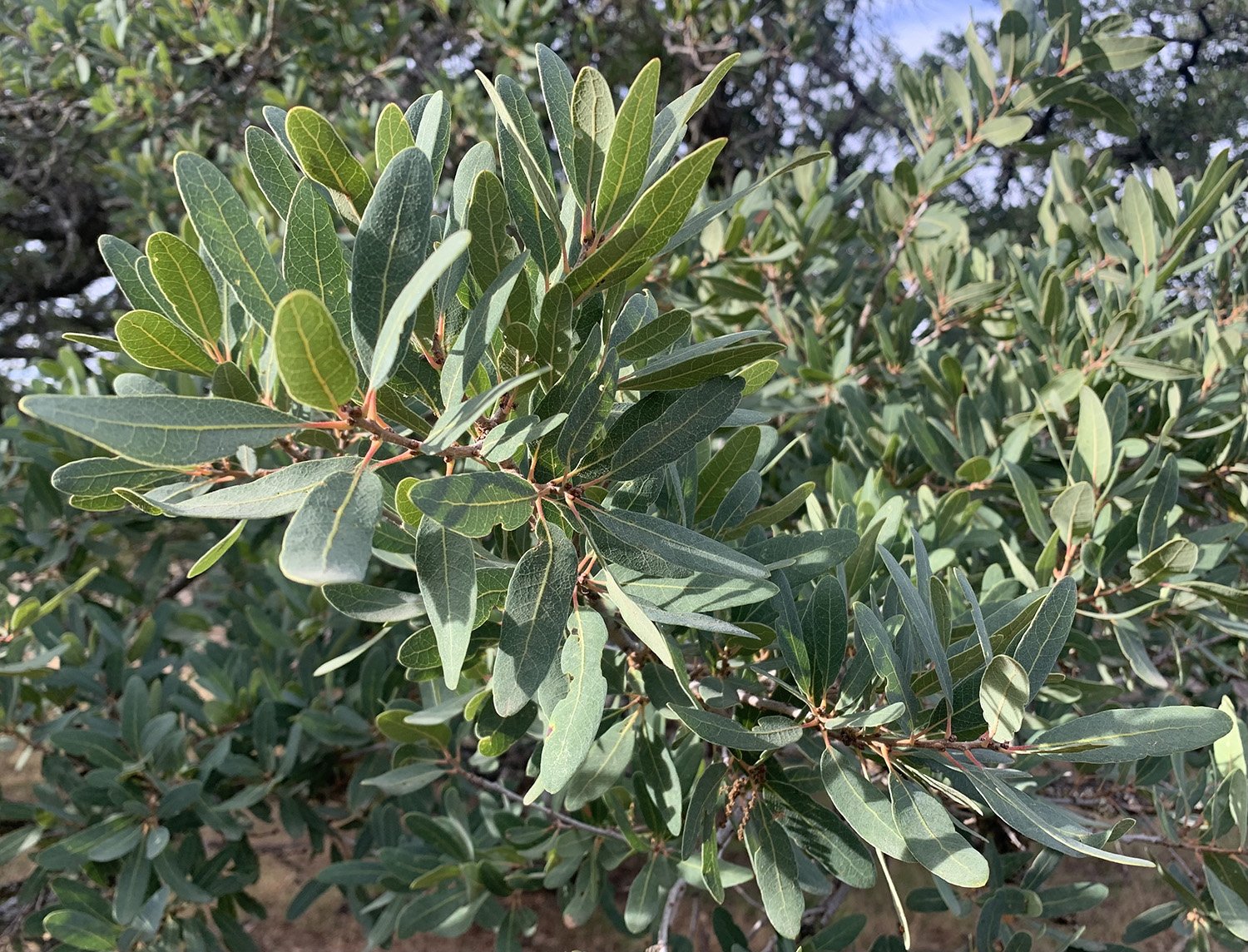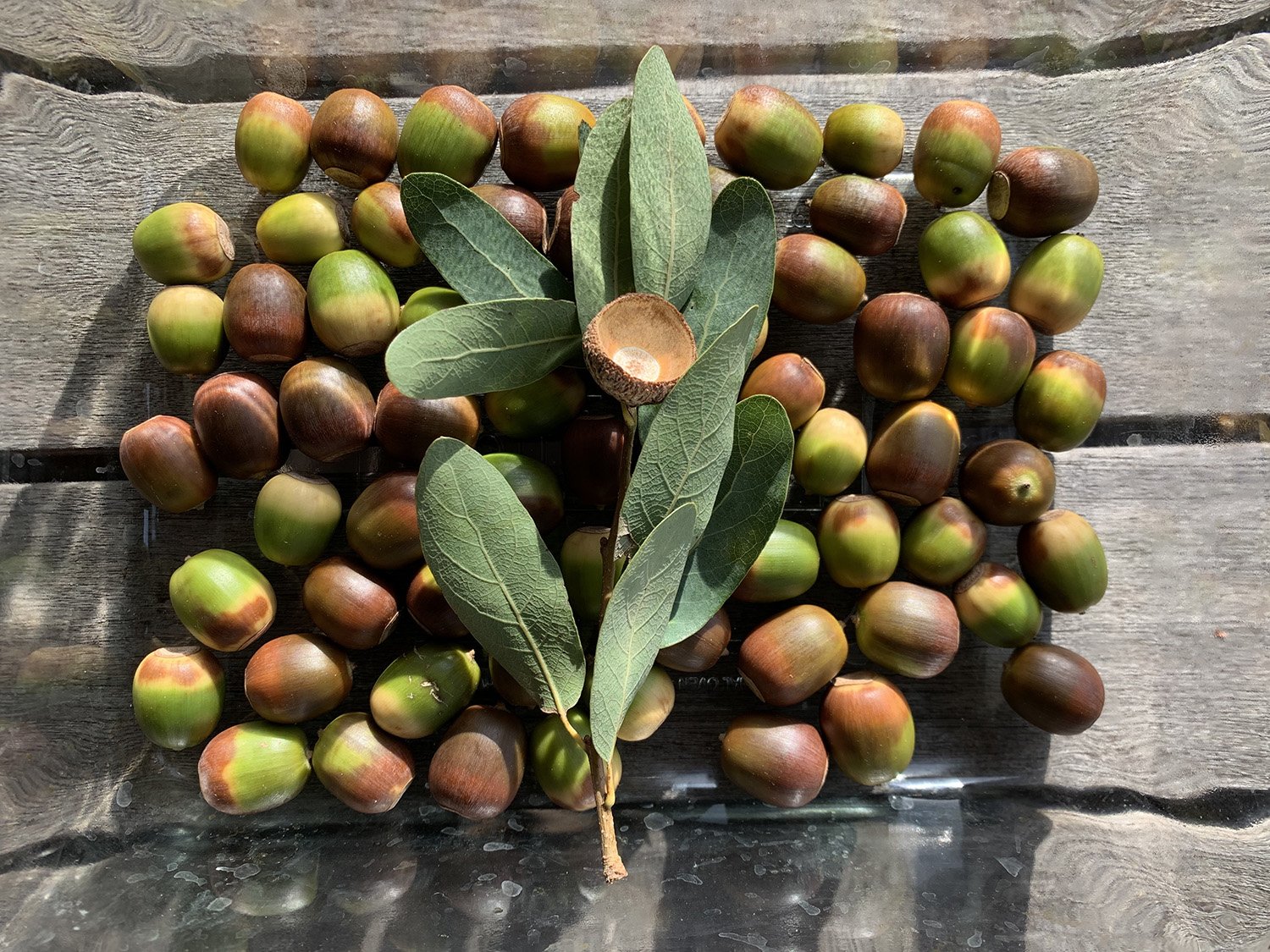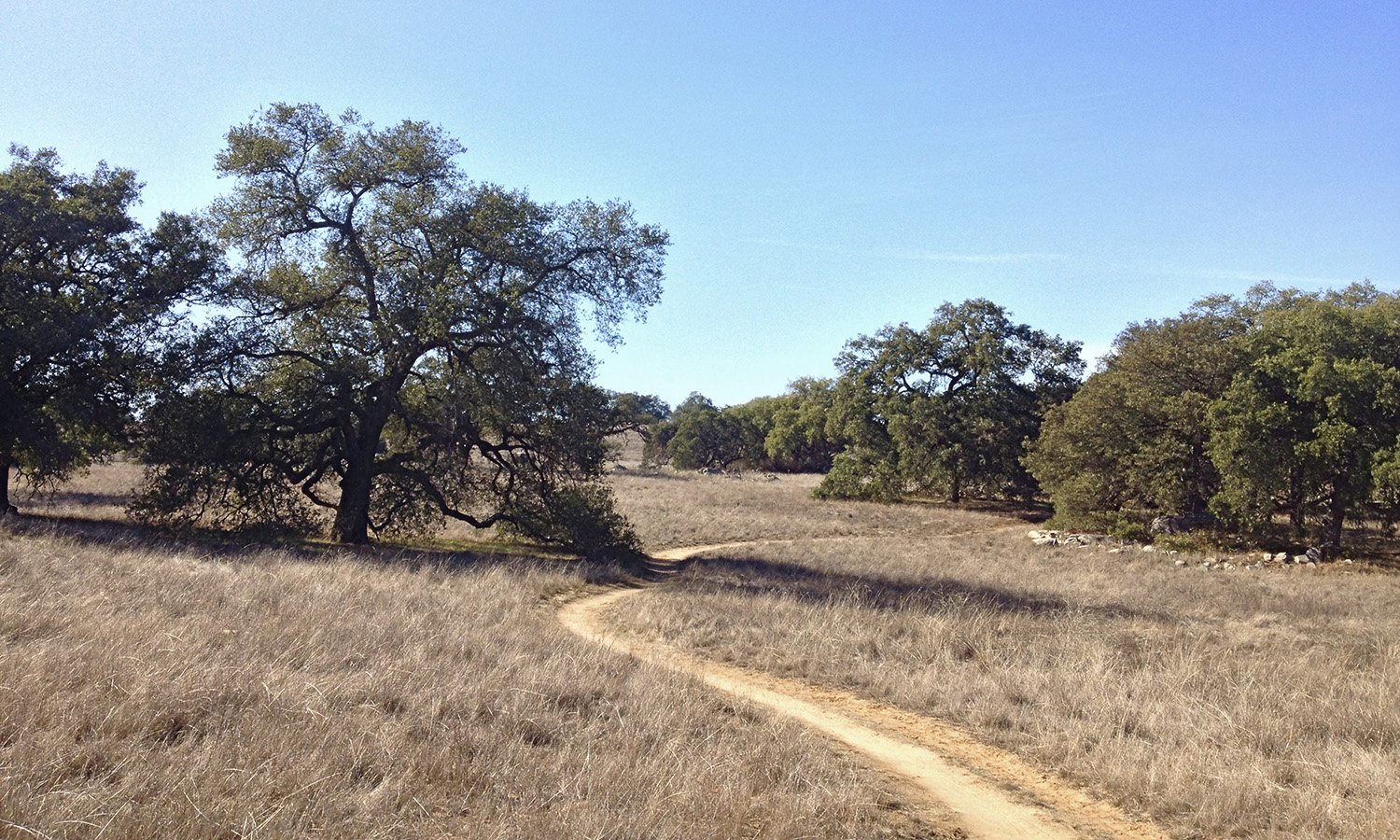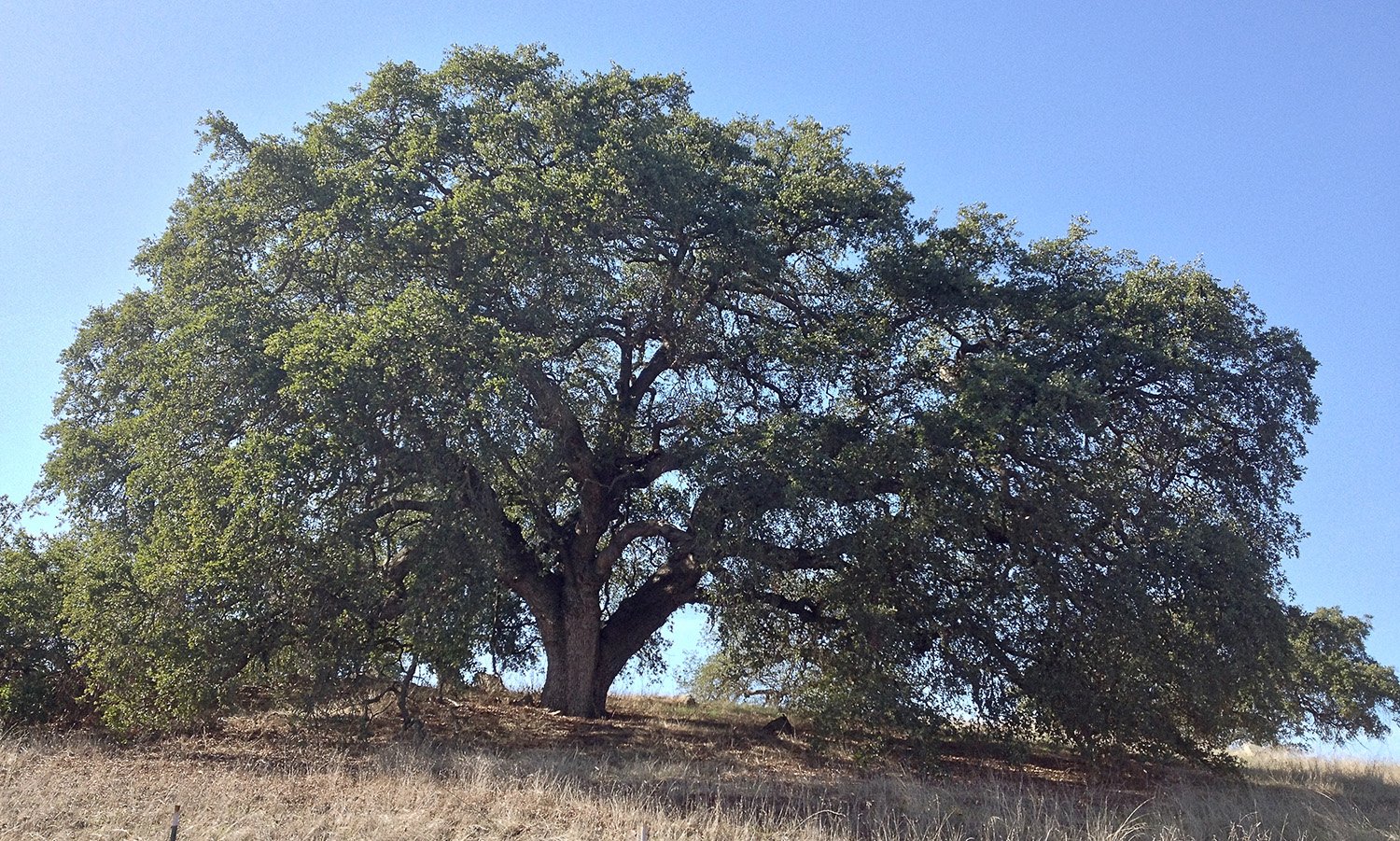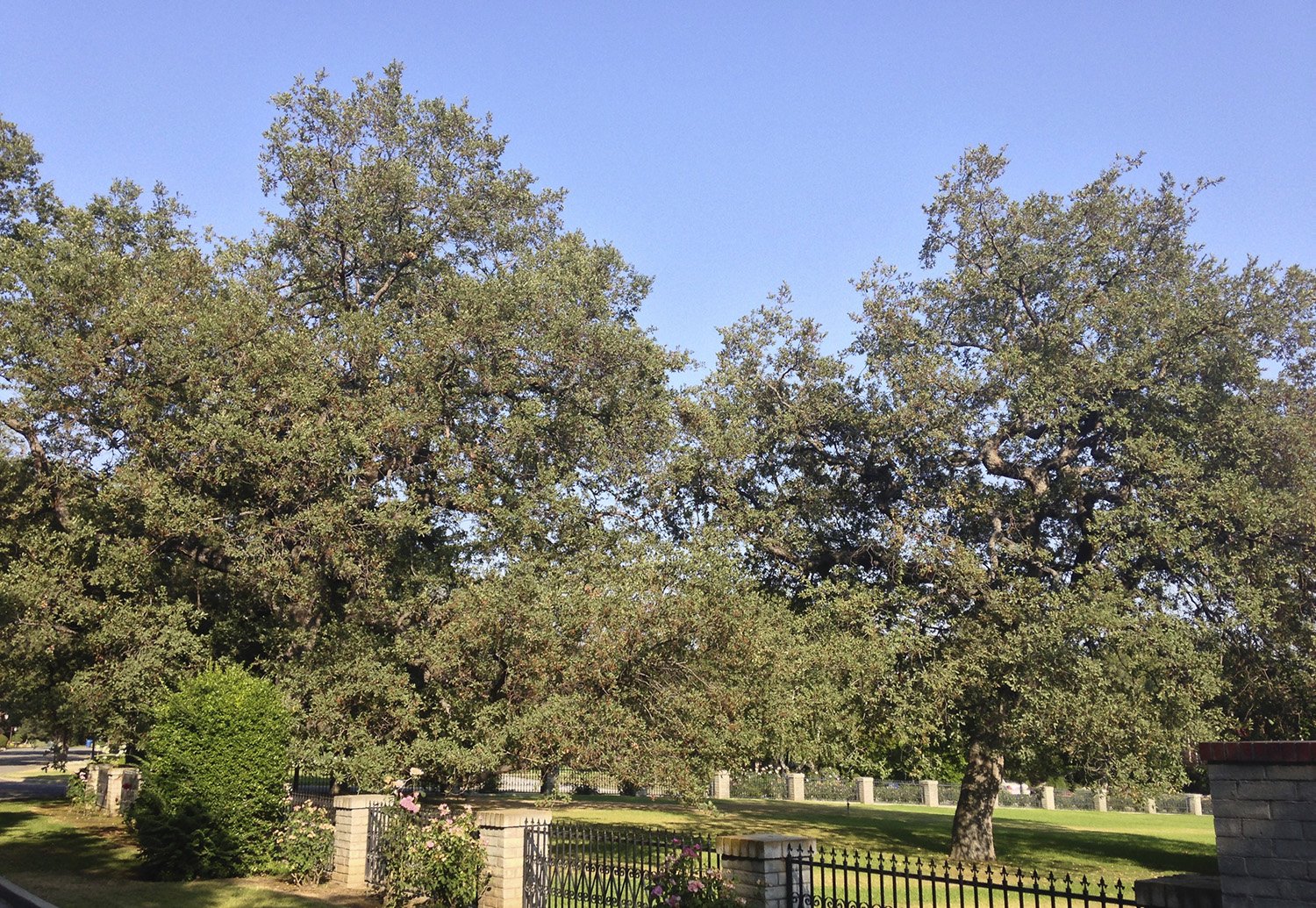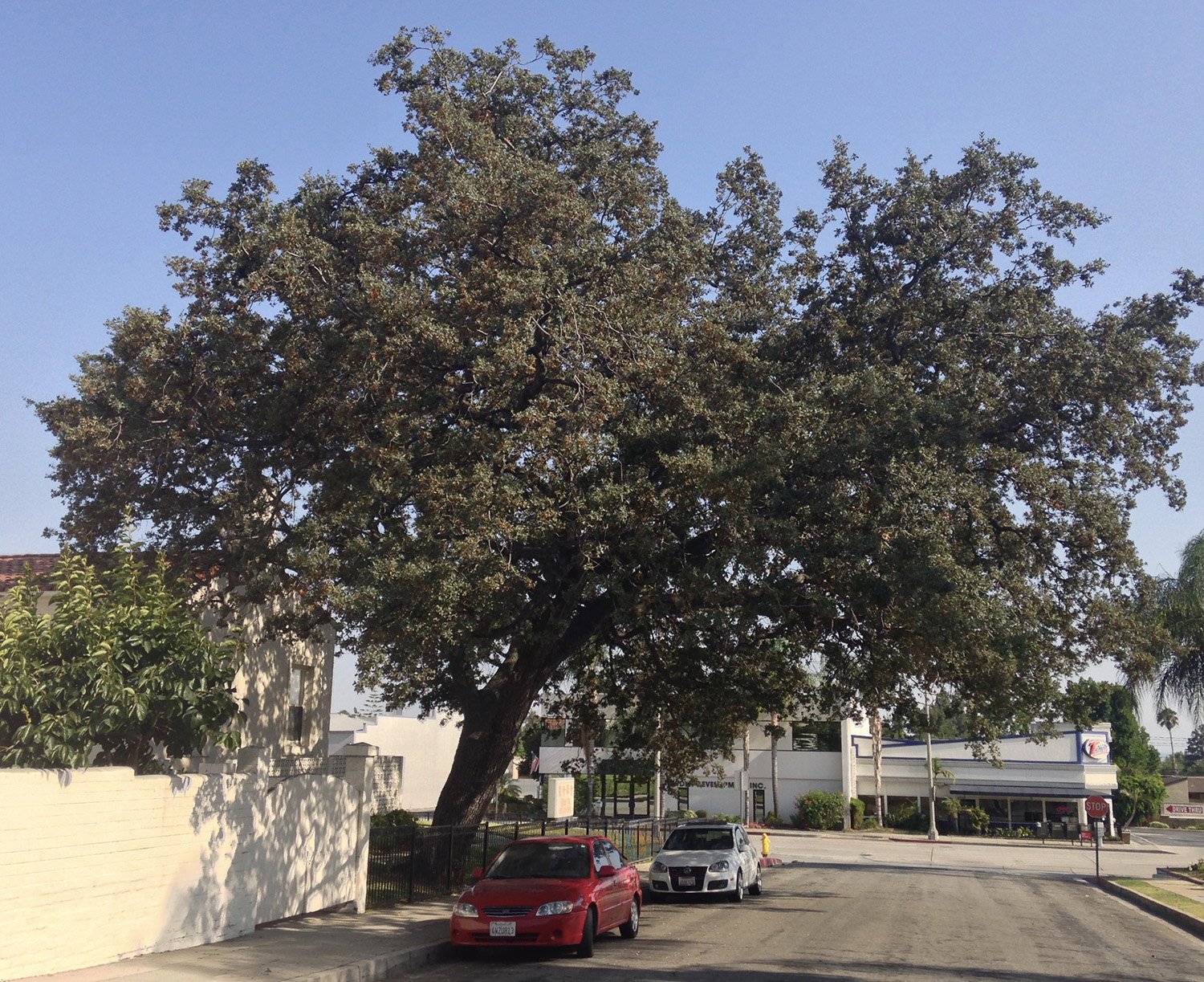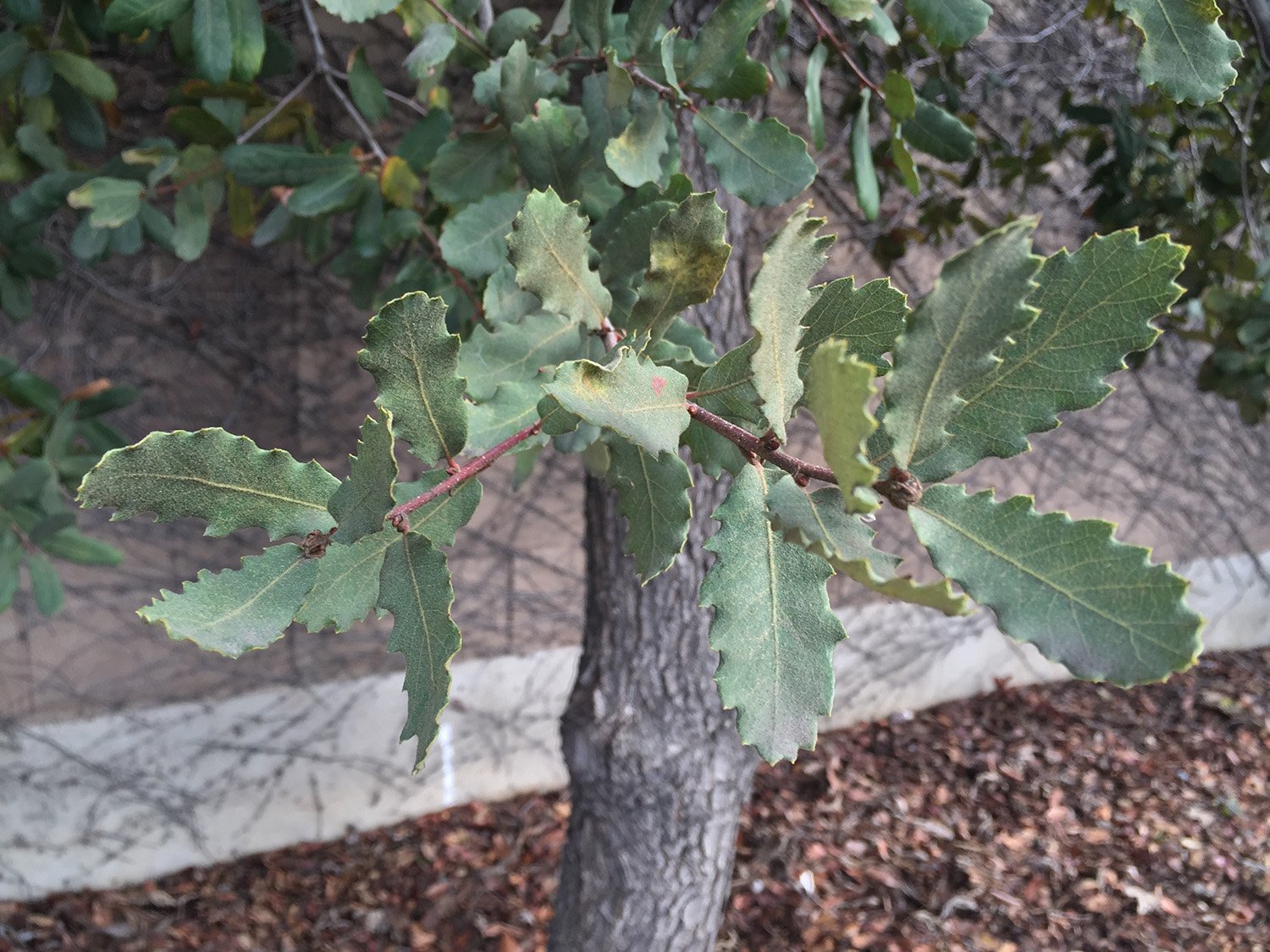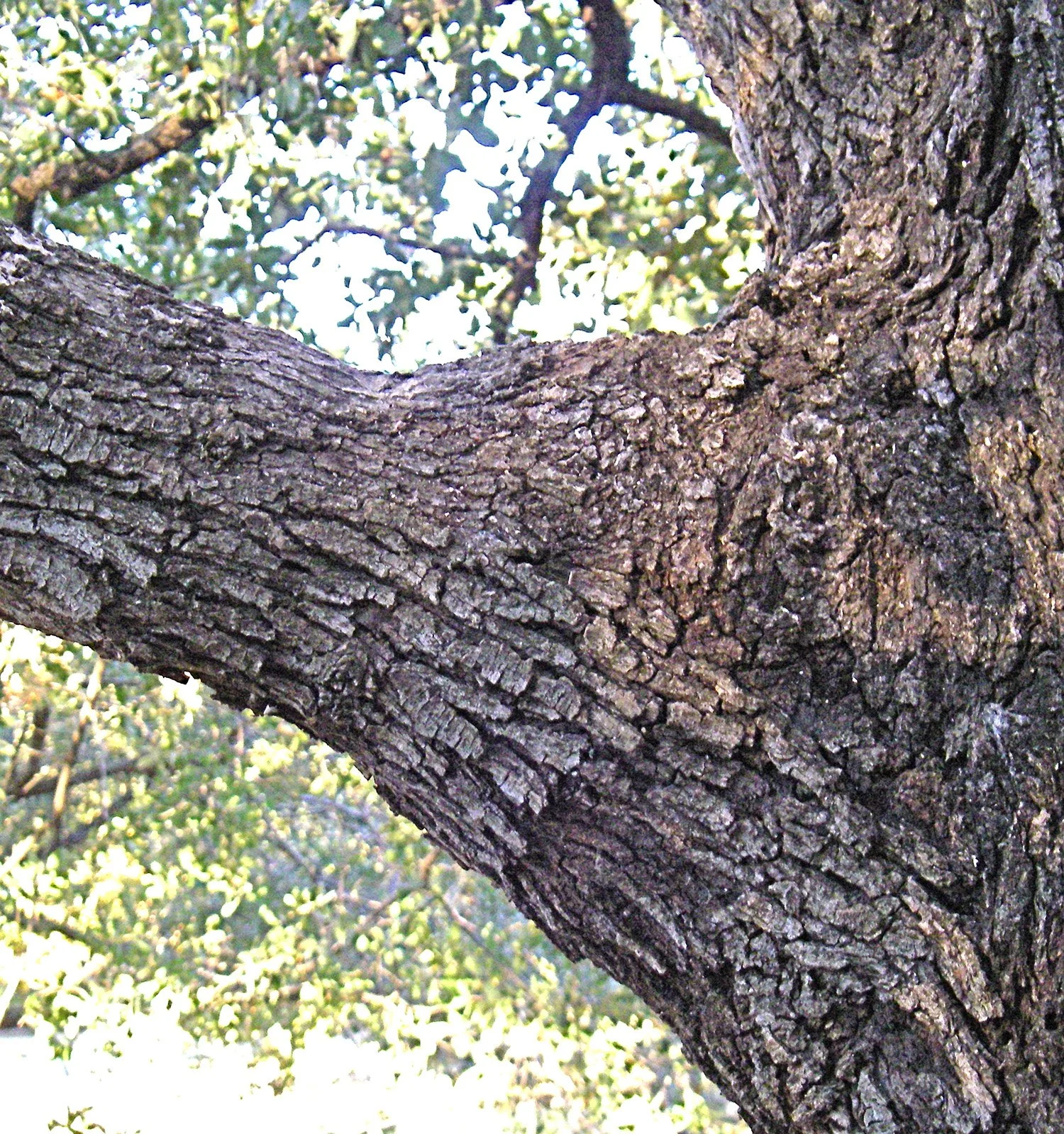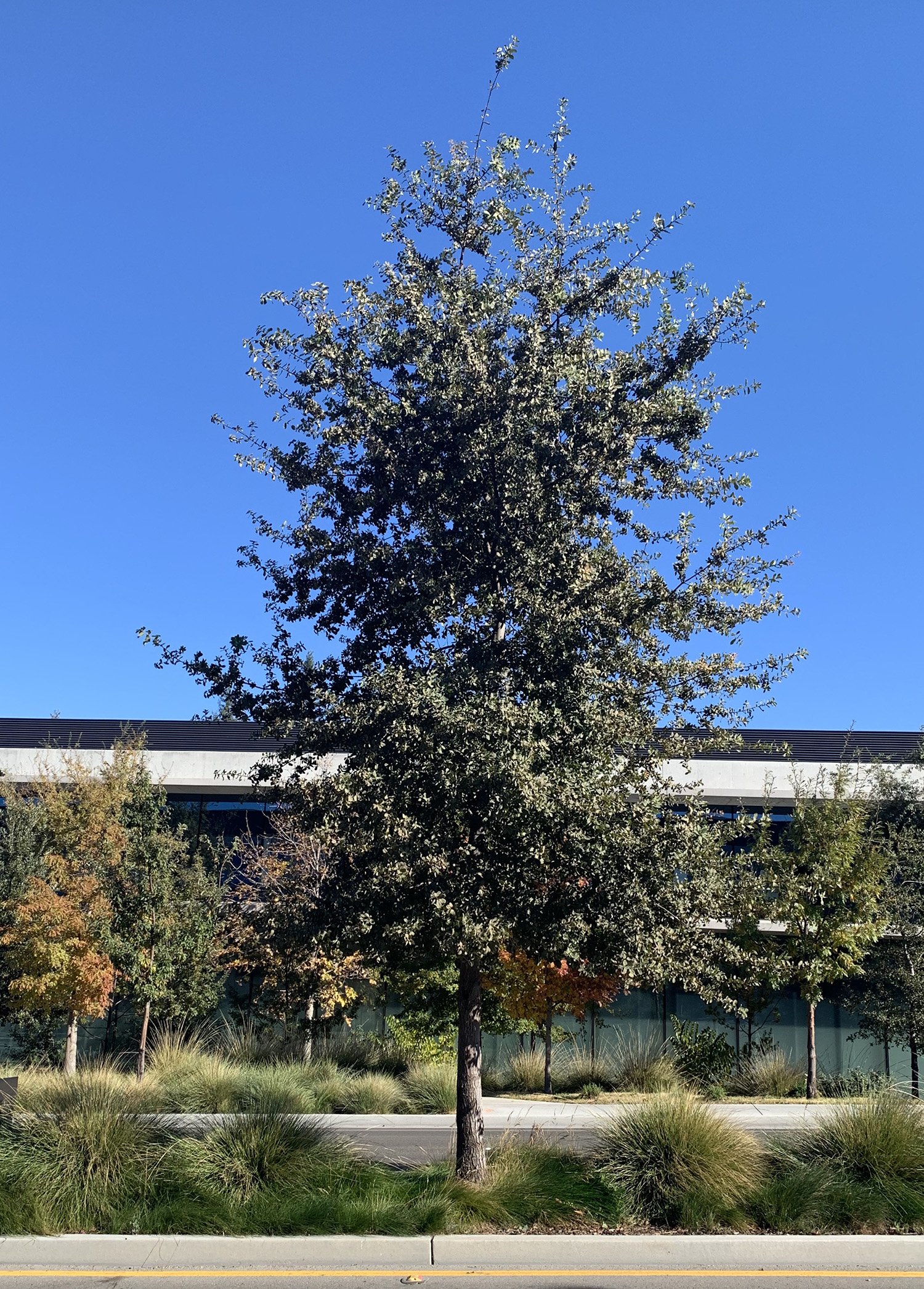Engelman Oak - Breaking the Code
A beautiful scene created by some old friends: oaks, rocks, and hills. Inviting, eh? The Engelman oaks (Quercus engelmannii) near Santa Ysabel are, by far, the nicest Engelman oaks I've found in nearly 20 years of studying and exploring Engelman oaks throughout their native and introduced range.
Here's what the scene above looks like from the outside. Engelman oak is officially listed as a threatened species by the International Union of Concerned Scientists, categorized Threatened (IUCN Red List Category : EN).
This is a typical scene in the area around Santa Ysabel. Engelman oaks are dotted around the rim of the valley. You don't really see Engelmans on the valley floor, but this may well be a remnant of their removal for previous agricultural use of the land on the valley floor. As you can see, the Engelmans are performing well right now, while oaks of many types throughout California are showing clear signs of stress. These Engelmans also appear to have less stress than Engelman oaks in other parts of southern California that I've surveyed.
There is certainly a "stress gradient" apparent in the Engelman oak population around Santa Ysabel, but the gradient is less extreme than in other Engelman areas. Trees near the bottoms of the hills are more densely foliated, and are much more likely to be carrying a crop of acorns. You can see some stress in the tree on the right, but as you move downhill, the density improves. There is currently an overall drop in ground water availability throughout California, and other arid parts of the world, and what you see here fits that scenario.
But while the Engelman oaks thrive, there are clear signs of mortality and stress in the intermixed coast live oak (Quercus agrifolia) populations as shown here. The evolutionary roots of Engelman oak are firmly amongst the Madro-Tertiary Geoflora, extending far south into Mexico, which experiences only a monsoonal climate, featuring some winter rains. Interestingly, this monsoonal climate closely mimics the landscape irrigation typically applied in California urban landscapes. This fact is suggestive that Engelman oak will be a strong urban performer in coastal California, and early testing in the Bay Area is confirming this hypothesis.
From direct observation throughout the Santa Ysabel area, the big dead trees are mostly coast live oaks. So here we have an area where Engelman oak appears to be thriving, and the coast live oaks are often declining. But why? The key may lie in the monsoonal rainfall adaptation of Engelman oak, all of whose close relatives are native to areas of monsoonal, or dry season, precipitation. Coast live oak is adapted to true Mediterranean conditions, with only rare rainfall during the summer. The southern extent of native coast live oak range coincides with the transition from Mediterranean climate to monsoonal climate. In fact, this kind of summer moisture is exactly what's been noted to kill coast live oaks throughout California, with the warm season moisture initiating root rot.
Here's another gorgeous Engelman oak near the valley floor outside Santa Ysabel. This is a particularly wide-spreading specimen, with a rock friend.
Here are two more beautifully healthy Engelman oaks in the Santa Ysabel area. The tree on the left has a moderately upright growth habit, and would be considered a superior Engelman mother tree for urban trees, especially as it is surrounded by other superior Engelman oaks. The tree on the right has an exceptionally upright growth habit, with the most apical dominance I personally have ever seen in an Engelman oak. This is an ideal urban Engelman mother tree.
Here is the tree from the right side of the preceding photo. This tree has grown with a surprisingly upright growth habit, which means this tree, if it produced acorns, would likely have seedlings with the same trait. An upright growth habit is just what's needed for low hassle growth in urban areas, where an upright growth habit can save thousands of dollars per tree in pruning to get the trees growing above pedestrians and vehicles, achieving adequate clearances for vehicles and pedestrians, and keep it that way.
A very wide-spreading example of Engelman oak. Here, cattle are still allowed to graze and browse, and their work can be seen on the lower canopy. I saw evidence of cattle eating lower branches of trees filled with acorns.
Here's an example of the typical foliage of Engelman oaks in the Santa Ysabel area. There is some variation in leaf size and coloration from individual to individual, but the overall leaf shape, texture, and venation is retained throughout. Note also the reddish leaf petioles, an unusual trait among Engelman oaks. The petiole color and overall leaf shape indicate that the rare Toumeyi's oak (Quercus toumeyi) was involved in the ancestral populations of tree from which the Santa Ysabel Engelman ecotype evolved. https://www.inaturalist.org/observations?place_id=any&taxon_id=167671
Here you see some acorns collected from road edge trees in the Santa Ysabel area. Acorn ripening appears to have been slowed this year by cool temperatures and bouts of summer monsoonal rainfall in this unusual pocket of California. Note the venation on the leaf underside - this appears much like the venation that can be found on the Arizona white oak (Quercus arizonica), a very close relative of Engelman oak, and likely one of the oak species from which Engelman oak originally evolved.
More roadside-collected acorns from the Santa Ysabel area. Here I want to point out that the acorn grows on a peduncle, the short stem from the leaf base to the acorn cup. This is NOT a typical feature of Engelman oaks, though there can be little doubt that the tree in question is an Engelman oak. Trying to fit oaks into species categories is like putting on ill-fitting shoes. Among the close relatives to Engelman oak, only the gray oak (Quercus grisea) and the netleaf oak (Quercus rugosa) have notable acorn peduncles, with gray oak being the more likely evolutionary root of this local ecotype trait.
Engelman oaks, different population. This is the Santa Rosa Plateau, above Murietta. These protected oaks are among the most accessible Engelman oaks in California. These trees show clear differences from the Engelman oaks in the Santa Ysabel area.
Here's one of the largest, and presumably most ancient, Engelman oaks I have ever seen. Extrapolating from other oaks in California which have been cored to determine their age, this tree is 250 to 350 years old. As few people seem to know, the last truly extreme drought in California lasted for nearly a century, and ended about 350 years ago. Outside of the mountainous areas of California, which continued to receive precipitation during the drought, the oldest low elevation oak trees in California are roughly 350 years old. This may well be one of them.
This is a medium size but mature Engelman oak hybrid. On the higher, drier areas of the Santa Rosa Plateau, scrub oaks can be found, Quercus x acutidens. In the lower, moister areas of the Plateau, there are few if any scrub oaks, and pretty much all Engelman tree form oaks, of several distinct ecotypes. But in the areas between, medium size trees can be found, which clearly appear to be hybrids between the Engelman oaks and the scrub oaks.
Here is a random collection of leaves from a variety of individual trees gathered on a walk around the Santa Rosa Plateau preserve. This is a much larger range of leaf size, texture, and color variation than can be found with Engelman oaks in the Santa Ysabel area. Also note that there is no evidence of the reddish leaf petiole which is common to Engelmans around Santa Ysabel.
Notice how thin and stressed the canopies of the edge trees are by comparison to the center tree, which is showing a dense and healthy canopy. Though not well captured in the photo, the thin, stressed trees have distinctly bluish foliage, and a rather airy growth habit. The center tree is much more dense and compact, with distinctly greener leaves. All are clearly Engelman oaks, but are notably different ecotypes. Interestingly, there are several of the bluish ecotype Engelman oaks at the Shields Oak Grove at the University of California Davis Arboretum, and they are historically weak performers. The Shields Grove also has some of the darker ecotype trees, which again appear to be performing more strongly than the bluish types. Interestingly, the Santa Ysabel ecotypes appear, from limited observation, to be equal to the stronger types in growth vitality. This hypothesis invites further testing.
Most of the Engelman oaks which I've grown have shown a strongly upright or apically-dominant growth habit. This young tree, in a small, moist area of excellent oak regeneration on the Santa Rosa Plateau, shows the typical growth habit. Please keep in mind this tree is in the middle of a nature preserve, and has received no structural pruning. Structural pruning is often a crutch, to allow the use of poorly-structured and poorly-adapted trees in urban areas. Choosing species and mother trees carefully reduces the need for structural pruning, which, frankly, is rarely done anyway, and often done improperly when implemented. Superior tree selection is a much more robust solution to managing long-term urban tree maintenance costs than structural pruning.
Here's an Engelman oak (shown with Charlie Jancic), in the Fallbrook area. This is another Engelman oak with natural apical dominance, and little work needed to achieve and maintain required urban clearances for vehicles and pedestrians.
Here's another Engelman oak in the Fallbrook area, this time an old tree which has had a nursery added above the majority of its root system. For most California oaks, the addition of this level of dry season watering would almost certainly doom the tree, and likely quickly. This Engelman oak shows no stress symptoms (in fact showing great vitality), and a root crown inspection of the tree revealed no sign of typical root decay associated with excess watering. Engelman oaks can handle summer irrigation if soil drainage is sufficient.
Here's another surprise with Engelman oaks and water. Typically, adding a lawn to a California native oak will spell fairly rapid death to the tree. But here, in Arcadia, in a neighborhood built in the 1950's, you can see dozens or hundreds of Engelman oaks, at least 50 years old, surviving and thriving in lawns.
It's hard to know whether the Engelman oaks in residential Arcadia are planted, or if the neighborhood was built around them. This area is definitely historically Engelman oak habitat, with native Engelman oak groves at the Los Angeles County Arboretum only about a mile away. Regardless, most of these Engelman oaks look good.
More big Engelman oaks in lawns in Arcadia.
This is likely to be an Engelman oak that existed prior to the construction of the buildings and infrastructure around it. The tree is thriving, and, once again, a substantial volume of the root system receives lawn irrigation.
This is a close up of the base of the tree above. The tree has clearly seen some damage to the base over the years, looking at the bark, possibly one or more car strikes. The roots here appear quite deep, because the pavement nearby appears to be both old and flat. Oaks, especially arid zone oaks, are often more deeply rooted than other trees, and many types cause less pavement and infrastructure damage than other trees over the long term. There are exceptions to this, particularly among the red oaks of the eastern United States, with red oak itself (Quercus rubra) as a noted pavement breaker in urban California.
Now we visit the Shields Oak Grove at the UC Davis Arboretum. This is the first place I ever saw Engelman oak, and what I found there left me confused in ways that have taken me more than a decade to resolve. This photo shows the foliage of the nicest of the Engelman oaks at the Shields Grove, and the whole tree is shown below. This tree produces copious acorn crops regularly, and this tree is the acorn source for most of the Engelman oaks grown in northern California over the last 40 years. I have grown many seedlings and saplings from these acorns, and the results have been decidedly mixed.
Here is a more complete view of the tree discussed in the photo above. Taking photographs of trees growing in close woodland is very challenging, as can be seen here. Regardless, the vitality and upright growth habit of this specimen show clearly. Interestingly, after first learning this tree as Engelman oak, my subsequent explorations of Engelman oak in native habitat strongly suggest this tree is actually a hybrid, with an unknown pollen parent. Hybridization explains the vital growth, and abundant acorn crops. But this creates a situation where the offspring of this tree are actually hybrids of a hybrid, and the offspring are indeed decidedly diverse, in unpredictable and random ways. I no longer use this tree as a mother tree owing to the unpredictability.
Here is one of those offspring of the tree above. This tree was planted from a #15 container in 2007, on excellent soils in East Palo Alto. It received supplemental irrigation for the first 3 to 5 years, and has since been growing on the often scant rainfall that nature has provided over the last decade. As is often the case with hybrids, this tree is a copious acorn producer, though the offspring grown from those are highly unpredictable genetically. This tree is part of the East Palo Alto Tree Initiative organized by Canopy, the tree non-profit in Palo Alto serving the Mid-Peninsula. On the other side of that soundwall is the 101 Freeway.
Here is a leaf closeup from the tree shown above. Similarity to the mother tree is clear, and, again, this leaf form is outside the range of what can be found in the wild. Please notice also the reddish young stems. A lovely tree, but not easily decoded or reproduced.
From Stanford University, here is another offspring of the Shields Grove big mama Engelman hybrid. This tree is grown from an acorn I collected at the Shields Grove in October of 2003, and it was planted by the ecological service organization Magic in the Stanford Arboretum in 2006. The tree received two years of volunteer bucket watering during the dry season of its first two years, and has subsequently grown without supplemental irrigation.
Leaves of the Stanford Engelman oak shown above. Again, similarity to the Shields Grove mother tree is great.
Another view of the big mama hybrid Engelman oak in the Shields Grove.
The structure of the big mama Engelman hybrid at the Shields Grove is truly impressive. Excellent branch angles and attachments are evident.
Another view of the impressive branch structure of the Shields Grove big mama Engelman hybrid. Some questions for arborists. If you were asked to remove this branch, where might you make the final cut for a textbook branch removal? And what might the client say if you cut this particular branch properly?
This is another offspring of the big mama Engelman hybrid at the Shields Grove, planted from #15 container in 2007. This tree shows a sprawling, pendulous growth habit, which is expensive and difficult to manage. This tree is quite unlike its siblings shown earlier, and much less desirable. The desirability of a given individual oak of unknown parentage takes years or even decades to play out, making mistakes expensive and difficult to rectify.
Here are the leaves of the tree shown above. The lobing at the leaf edge is suggestive of hybridization from the Chestnutleaf oaks (Quercus castaneifolia x cerris) that grow across a large previous lawn area from the Engelman oaks.
A better, but still notably pendulous, offspring of the big mama Engelman hybrid at the Shields Grove. Pendulous branches make maintaining vehicular clearances demanding and expensive, and such trees are strongly disliked by Caltrans road maintenance personnel.
Engelman oak is quite possibly the #1 underutilized tree in urban coastal California. So far as I've been able to discover, there is not a single street planted with Engelman oaks in all of California, but here it is in Australia. This is an allée of Quercus engelmannii on Caldenia Street, Canberra, Australia. Photo credit to Roderick Cameron, in the International Oak Society blog: https://www.internationaloaksociety.org/content/californian-oaks-canberra.
But there will be many more Engelman oaks in urban California in years to come, as superior individual trees are identified and reproduced. Here's Engelman oak thriving near the main entrance to the new Apple headquarters, Apple Park, in Cupertino. The trees are performing beautifully.
Another excellent young Engelman oak growing on a road median at Apple Park in Cupertino.
Engelman oak can make a great nursery tree, as shown here.
